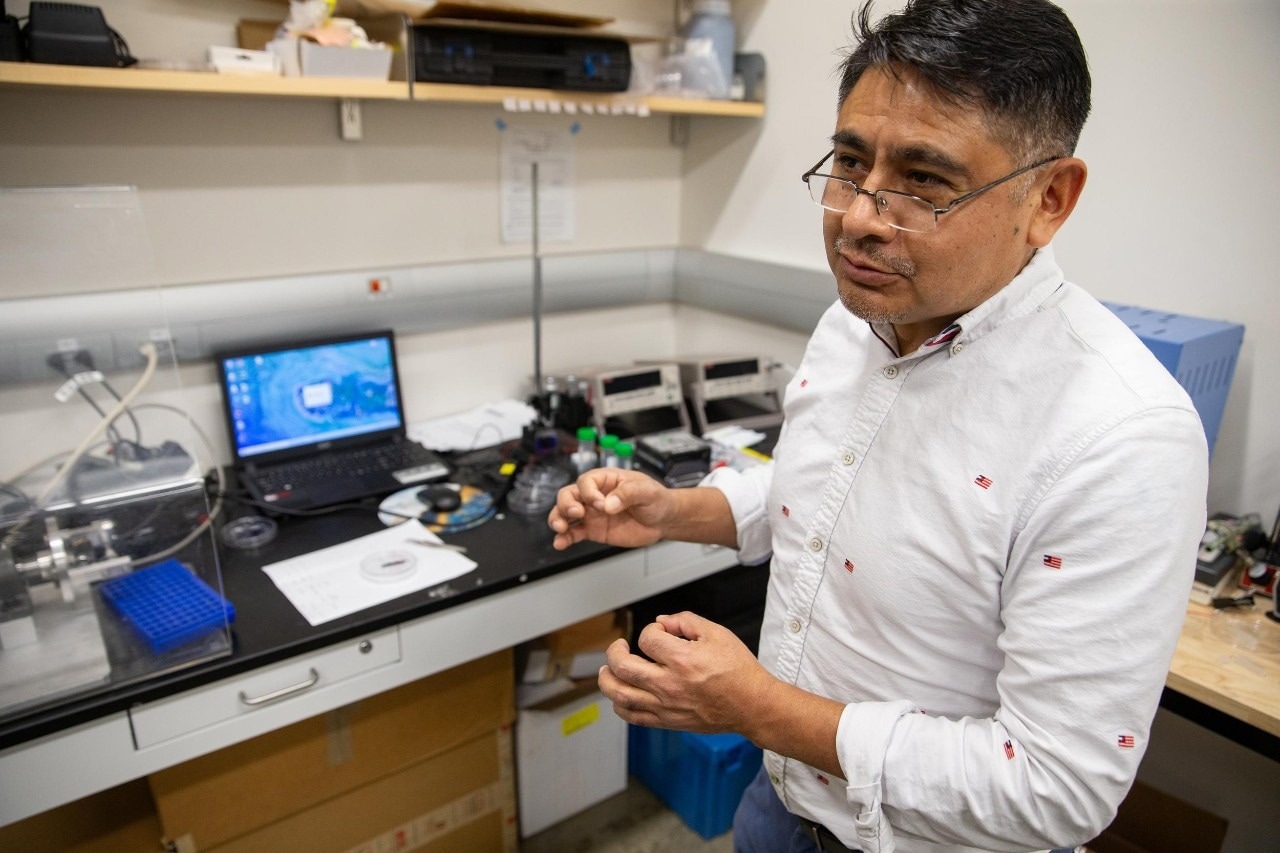Carbon nanotubes have demonstrated potential in various fields, including energy storage, microelectronics, and aviation.
 UC Associate Professor Noe Alvarez is studying the properties of carbon nanotubes in his chemistry lab. Image Credit: Andrew Higley/UC Marketing + Brand
UC Associate Professor Noe Alvarez is studying the properties of carbon nanotubes in his chemistry lab. Image Credit: Andrew Higley/UC Marketing + Brand
Scientists believe that this material could one day realize the enticing idea of building a space elevator found in science fiction.
Why, therefore, are not they employed more often?
One challenge, according to chemist Noe Alvarez of the University of Cincinnati, has been the vexing inability to securely attach carbon nanotubes to metal surfaces for use in transistors, sensors, and other applications. These hollow tubes can span many centimeters in length, yet their diameter is only a billionth of a meter.
We want our experiments to be reproducible and consistent, but that is not easily possible with nanotubes because we can’t control how well they are connected to metal surfaces.
Noe Alvarez, Associate Professor, University of Cincinnati
However, he and his associates have developed an innovative chemical procedure that grafts metal surfaces with nanotubes to form a robust, reliable, and conductive connection. The study was published in the Nanoscale Advances journal.
In previous versions, Alvarez compared it to “wet spaghetti” as carbon nanotubes were scattered in a solution and adhered to a metal surface.
Alvarez added, “But there is no robust connection. Nothing is really holding the nanotubes to the surface.”
As a result, measurements of attributes like electrical conductivity were erratic and inaccurate.
Under the direction of Jorge Seminario, a professor of chemical engineering at Texas A&M University, Alvarez and his research colleagues showed how to chemically attach nanotubes to copper, aluminum, gold, and other metal surfaces.
The National Science Foundation awarded Alvarez and his associates a $720,000 grant to further develop their chemical discovery over the course of the following three years.
Why don’t we see carbon nanotubes in widespread commercial applications even though they have so much potential? We have a lot to figure out.
Chaminda Nawarathne, Study Lead Author and Doctoral Student, University of Cincinnati
Through computational calculations, Alvarez and his co-authors found that the organic link's carbon atoms form a strong bond with two copper atoms.
Alvarez stated, “That explains why our nanotubes once they’re chemically connected stay connected.”
According to Alvarez, carbon nanotubes are renowned for their strength. An exquisite hexagonal lattice is produced by their molecular structure.
“Carbon bonds are the strongest bonds. They are covalent bonds. That is why diamond is the hardest material because they are carbon-carbon bond,” Alvarez noted.
According to Alvarez, carbon nanotubes are even stronger than diamonds since they include conjugated double-bonded carbon atoms instead of the single bonds seen in diamonds.
Strong yet lightweight carbon nanotube cables have been proposed for use in “space elevators,” which might carry equipment into orbit, according to Alvarez.
Earth’s blackest synthetic substance is made of carbon nanotubes. Better paints and coatings might result from their strong ties to metal, according to Alvarez.
Alvarez stated, “Nanotubes are fairly inert. They are very stable. You can conjugate them without breaking their bonds. Semiconducting nanotubes also have fluorescence properties — they can generate light. So, the list of applications goes on and on.”
According to Nawarathne, he is investigating possible uses for energy storage.
“Now that we can bond the carbon nanotubes to a current collector or metal probe, we can make very stable electrodes for supercapacitors,” Nawarathne added.
Catalytic chemical vapor deposition is a technique used by UC Chemistry students to “grow” nanotubes on silicon disks. The device involves heating reagents and an iron catalyst to 1,450 degrees Fahrenheit.
A small layer of carbon nanotubes forms on the silicon after 45 minutes. After that, the nanotubes could be electrografted onto different metal surfaces by researchers. They first employed bundles of nanotubes, but they have now discovered how to join vertically aligned nanotubes using improved procedures.
He concluded, “It is like trying to connect wool back to a sheep. You have yarn that has been sheared from the sheep. We are able to connect individual fibers back to the sheep chemically.”
Journal Reference:
Nawarathne, C. P. et. al. (2024) Creating covalent bonds between Cu and C at the interface of metal/open-ended carbon nanotubes. Nanoscale Advances. doi:10.1039/D3NA00500C.